There are 9 skinks found in Florida, six are natural to the area, while three have been introduced.
Skinks are secretive ground-dwelling lizards, many will burrow. They are cylindrical in shape, many with cone-shaped heads and long tails that taper. Some have short legs, while others are often confused for snakes, being legless.
They can be found in temperate regions in Northern America.
The good news is that skinks are not poisonous or venomous. Some people may be worried due to the bright color of some of the species, assuming they are dangerous.
Skinks are more scared of you than you are of them, they will try and run for cover or hide in a burrow if approached.
1. Mole Skink
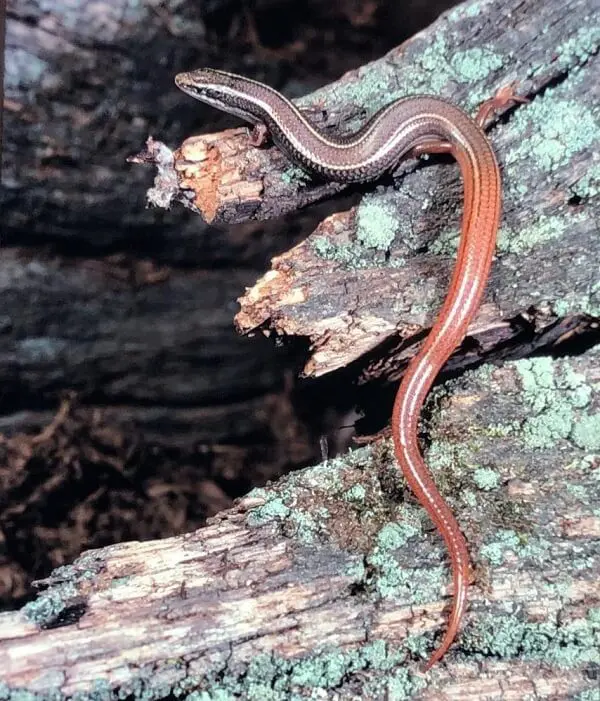
Mole skinks (Plestiodon egregius) are mostly found in sandhills and shrubs. They prefer burring themselves underground.
They reach sexual maturity by the age of one.
These skinks can grow up to five inches (12.7cm) and are brown in color with a touch of pink on their tails.
They often have two or more lines extending from the head to the tail.
They have small legs with their tails taking up more than half their total length.
When they are younger, the tails tend to be blue. As they age their tails take on a pinkish coloration, as do regenerated tails.
During mating season, males have orange patterns on their sides.
They will give their tail if they feel threatened, sometimes playing dead.

2. Coal Skink
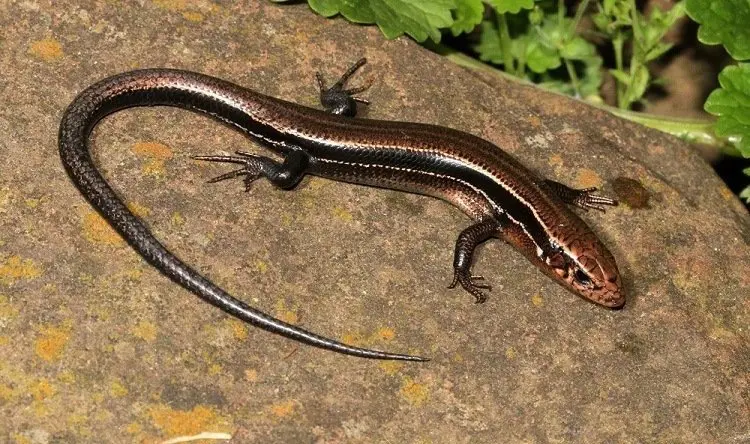
Coal skinks (Plestiodon anthracinus) can grow up to 7.1 inches (18cm) in total length, including their tails.
These skinks have four lines which run to the tail.
Males have red on their heads during mating season.
They prefer wooded hillsides which have plenty of leaf litter and loose stones where they can hide. They can also be found around springs.
When in threat, they will go into shallow water and hide under stones to escape their predators.
The sides of the head of the male are reddish during spring breeding season, at least in some parts of the range.
There are northern and southern coal skinks, the one you find in Florida is the southern coal skink.

Further Reading: 10 red / orange head lizards in the United States.
3. Florida Sand Skink

The Florida sand skink (Plestiodon reynoldsi) has adapted itself to live underground.
They grow up to five inches (13cm) in total length and are tan or gray in color with small legs.
The tail takes up about half of this lizard’s body, while their heads take on a wedge shape with small eyes, which allows the skink to move seamlessly through the sand.
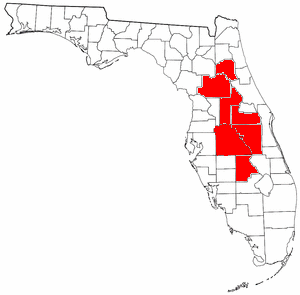
They can be found in vegetated areas with sand and shrubs. Their habitat is usually where there is an abundance of food supply and good moisture levels.
You often find them in the ecotone found between Florida’s rosemary scrub and pine flat woods, where there is moisture under the litter and in the sand.
The Florida sand skink burrows around 3.9 inches (10cm) under the soil when hunting for food.
They are a threatened species in Florida and have been classified as vulnerable since 2016.
4. Broad-headed Skink

The broad-headed skink (Plestiodon laticeps) is one of the largest skinks that can grow up to thirteen inches (33cm) in total length.
They have triangular-shaped heads, due to their wide jaw.
Males are olive-brown to brown in color with orange heads, which are displayed during mating season.
Females have five light stripes that run down their backs and their tails.
Juveniles are dark brown or black and may have some stripes. Juveniles are easily distinguished by their bright blue tails, which fade with age.

You can find the broad-headed skink in urban areas, but they prefer forests that are humid with plenty of leaf litter. They can be found on the ground and in trees.
5. Ocellated Skink

Adult ocellated skinks (Chalcides ocellatus) can grow up to twelve inches (30cm) in length and weigh up to 39 grams.
They have small heads and cylindrical-shaped bodies.
They are agile and have a variety of color patterns.
They prey on insects and can be found in a range of environments, including deserts and farmlands.
They will run for shelter in vegetation if they are threatened.
They are not fast movers due to their short limbs.
6. Rough Scaled Brown Skink

This moderate to large skink (Eutropis rudis) can grow up to 12cm from snout to vent and 34 cm in total length, including the tail.
They can be found in lowlands and rainforests, though they can adapt to dry and disturbed secondary environments.
They have a robust body with a pale-edged dark brown broad strip along the top of their flanks with pale underside.
Adults have varied throat colors which can be red or yellow, along with blue with black spots.
They have a rough skin appearance due to their raised ridge of dorsal scales.
7. African Five-lined Skink

This is a medium-sized skink that grows to around 7.9 inches (20cm).
They have varied colors based on their age and gender with glossy scales. Their basic color is usually dark brown to olive-brown with white spots and three light stripes that run from the head to the tail. The stripes tend to fade as the lizard ages.
They have pointed snouts and visible earholes, their legs are dark brown, strong, and short. They have a yellow flank and white bellies.
This is an invasive species to Florida, usually found in Egypt and Southern Africa.
These skinks prefer grassland and rocky habitats, where they live mostly in trees along with man-made structures.
8. American Five-lined Skink
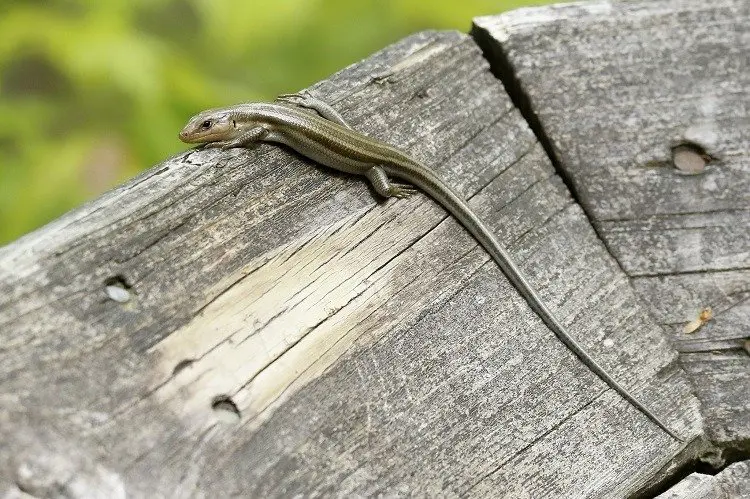
The American five-lined skink (Plestiodon fasciatus) is a medium-sized lizard that grows to 8.5 inches (21.5cm) in total length, including the tail.
When they are younger, they are black to dark brown in color with five white or yellow stripes and a bright blue tail.
As they age, the blue on the tail fades, sometimes the stripes also slowly disappear.
Adults tend to be uniform brown.

These are ground-dwelling skinks, that prefer wooded habits that are moist, with ample cover, along with plenty of basking areas, where they can soak up the sun.
Further Reading: 16 lizards with blue tails in the United States.
9. Southeastern Five-lined Skink
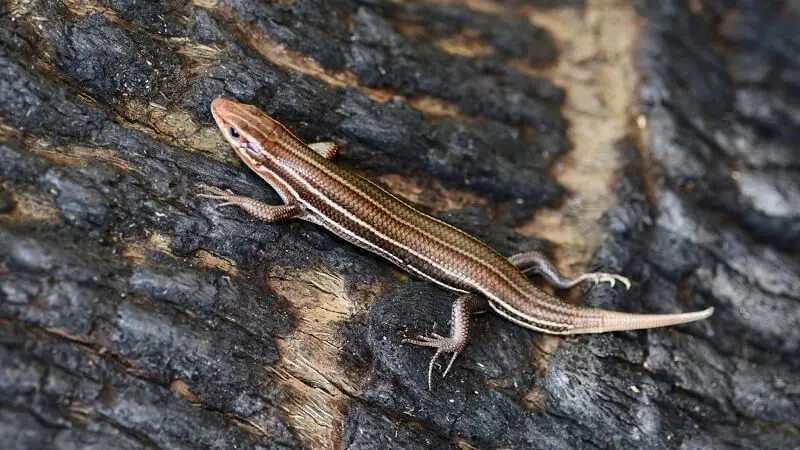
The southeastern five-lined skink (Plestiodon inexpectatus) has five stripes down the body that lightens with age. The middle stripe is narrower with dark areas found between the stripes.
Juveniles have bright blue to purple tails that fade with age, their stripes are also red to orange near their heads.
It’s not uncommon for this coloration to continue into adulthood, which can give the lizard an orange-brown coloration.

These lizards can be found in wooded areas, where they dwell on the ground.
Further Reading: